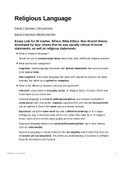Religious Language
Extract 2 Summary: Flew and Hare
Extract 3 Summary: Mitchell and Flew
Essay Link for 30 marker: Ethics, Meta Ethics: Boo-Hurrah theory
developed by Ayer shows that he was equally critical of moral
statements, as well as religious statements
What is religious language?
Words we use to communicate ideas about God, faith, belief and religious practice
What are the two categories?
Cognitive: realist language that deals with factual statements that can be proved
to be true or false
Non-cognitive: Anti-realist language that deals with statements that are not taken
factually, but rather as a symbol or metaphor.
What is the difference between univocal and equivocal?
Univocal- using words in everyday sense. In religious terms, it means ‘God’s love
is the same as my mums love’
Univocal language is at risk of anthropomorphism, but it makes it possible to
understand God’s love better. Aquinas supported this and said no characteristic
can be applied to God in the same way as humans/ animals.
Equivocal- using the same word but with a different meaning, or in a vague,
ambiguous way. It describes what God is not, rather than what he is. In religious
terms ‘God’s love is not the same quality as of my mums love’
Equivocal language allows us to avoid anthropomorphism, but it risks making
God too unknowable.
Equivocal language is closely related to the via negativa which holds that God can
be known yet not described. This seeks an understanding of God that is ineffable
(beyond description) and mystical.
Religious Language 1
, What is religious language as analogical?
Aquinas’ theory of analogical predication holds that since God created the
universe, then there must be some link between human attributes and God’s. In
other words the attributes are being used as analogies.
Aquinas identified two types:
The analogy of attribution- Compare the sentences: ‘the baker is good’ and ‘the
baker’s bread is good’. Here we are attributing the same quality (goodness) to two
different things. However, by establishing what ‘good’ means in the case of bread
we can understand something of what the same word means when applied to the
baker. In the same way, if we know what constitutes ‘good’ in the case of human
beings, we can understand something of what ‘good’ means in relation to the
creator of human beings, God. Put simply, God has whatever it takes to produce
human goodness.
The analogy of proportion- I can know that a dog can love, although it is an
inferior kind of love to the best human love. So I can make a ‘downwards’
analogy from human love to canine love, even though I don’t know exactly what it is
like for a dog to love. Equally, I can make an ‘upwards’ analogy from human love
to God’s love, even though I don’t know exactly what it means for God to love. So,
again, it is meaningful analogically to say that ‘God is good’.
What are the criticisms on analogy?
The analogy of attribution can be used to prove that ‘God is bad’.
A more powerful objection is that, for it to work, the language I use to describe
God has to be in part univocal and cognitive. There must be something in
common between God’s goodness and human goodness, otherwise I can’t
understand the analogy. But if goodness in God and humans is understood
univocally after all, then nothing has been gained.
Aquinas based his work upon a number of assumptions, such as God is
creator of Earth and humans are made in the image of him.
Analogy picks some qualities, but not others. Does God possess evil as
well? This was countered by Augustine, who argues that there is no such
thing as evil, just a privation of the good.
Religious Language 2




